Lingonberry: What Lingonberries Are & Why It's A Super Berry
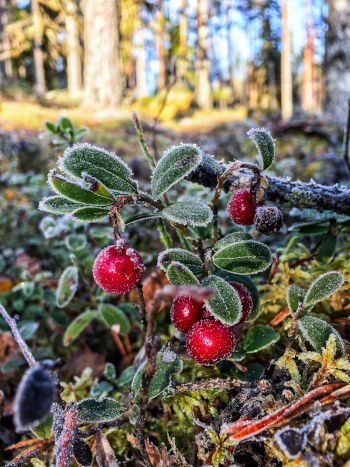
Lingonberries are considered super berries.
Why you may ask?
Lingonberries are so nutritional that they've actually saved lives. They've given children leave from school and you can pick them for free in the wild (at least in Scandinavia)!
Everyone doesn't like the taste. Lingonberries have a special tarty taste, but it's perfectly safe to eat it raw. It's actually the best way to eat it, if you are interested in the health aspects of the berry.
Lingonberries are quite similar to cranberries. There are some differences but in all recipes where you usually have cranberries you can easily substitute them to lingonberries.
Lingonberry is a berry that grows wild in Europe, Asia and North America. They grow in the northern hemisphere's forest belt. Lingonberries is very resistant to cold and grows even in snow It can withstand cold all the way down to -40 degrees. But if the summer is too hot, the bush won't grow that much and the harvest is negatively affected.
The lingonberry flowers have both stems and pistils on the same flower. This means that lingonberry bushes are able to reproduce themselves. This makes it easier for the lingonberry bushes to produce a lot of lingonberries under favorable conditions.
Table of Contents
How Did Lingonberries Save Lives?
In Scandinavia throughout the 19th century, many poor people had boiled potatoes and lingonberries as their main food. The potatoes were easy to grow and the lingonberries was freely available throughout the forests.
In the late 19th century landowners noticed that they could make money of lingonberries. This was the beginning of something similar to a gold-rush in Sweden that was later named the "lingonberry rush”.
The landowners started to employ people to pick the berries, even children got an extra leave from school in the fall when the berries are ripe, just so they could help with the picking of the berries.
If you are interested to read more about the Scandinavian history of these beautiful red lingonberries, you can check out our article Where do lingonberries come from?
How Nutritional Are Lingonberries?
Lingonberries are amazing berries, that contain lots of antioxidants, vitamins and minerals. Substances that are very healthy for us. Lingonberries are called super berries based on their nutritional value and well researched potential health benefits.
Antioxidant content in Lingonberries and Cranberries
Lingonberries are related to cranberries. They contain much of the same kind of nutritional substances.
One healthy thing they have in common is that they contain proantocyanans and polyphenols , which are a part of the red dye in the berries. Proantocyanans and polyphenols are antioxidants that help to protect our health.
A study made in Poland on the antioxidant activity on lingonberries ◳ showed that the lingonberries they tested, grown in Poland, are a rich source of dietary polyphenols with strong antioxidant activities.
Quercetin content in Lingonberries
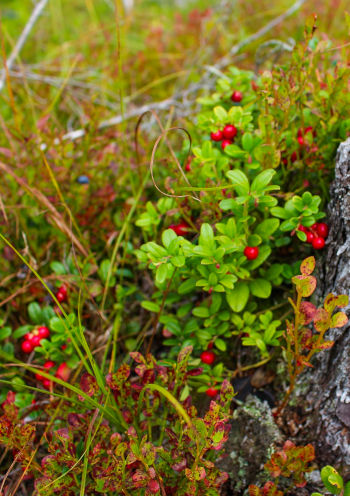
Lingonberries also contain quercetin, a flavonoid that functions as an antioxidant and anti-inflammatory agent. Quercetin is claimed to provide many beneficial effects on health, including protection against various diseases such as osteoporosis, lung cancer, and cardiovascular disease.
A study made on the biological importance of quercetin ◳ showed that there has been a reduction in the risk of cardiovascular disease in subjects, who had a high intake of the flavonoid quercetin.
Polyphenol content in Lingonberries
Lingonberries also contain the antioxidant polyphenol. It’s the pigment that colors the lingonberry red. The polyphenols may also contribute to the bitterness, astringency, flavor, odor and oxidative stability of the berries.
Researchers believe that the high levels of polyphenols in berries ◳ effects the human health.
As for example, the polyphnols may help you
- Maintain stable blood sugar levels
- Lower your cholesterol
- Prevent obesity
- Relieve inflammations
Research published in the Journal of Agricultural and Food Chemistry ◳ indicate that procyanidins found in lingonberry may help fight human cervical cancer and colon cells.
Vitamin content of Lingonberries
Lingonberries contain vitamin C, vitamin K, vitamin E, magnesium, potassium and phosphorus.
Eating about 100g of lingonberries provides you with 139% of the Reference Daily Intake (RDI) for manganese, a mineral that is a component of one of your body’s major antioxidant enzymes.
About 100g of lingonberries provides 12% of the RDIs for vitamin C and 10% of the RDIs for vitamin E.
Nutrient Content Of Lingonberries Vs Cranberries
Here's a chart comparing the nutrient content in lingonberries vs cranberries. We've selected some of the more important nutrients that you can find in both of the berries.
The data comes from the Swedish National Food Agency. If you're interested in checking other nutrients in the berries, you can do it here for Cranberries ◳.
Comparison Of Nutritional Values Of Lingonberries and Cranberries
| Nutrient | Lingonberries | Cranberries |
|---|---|---|
| Calories | 57 kcal/100g | 46 kcal/100g |
| Carbohydrates | 11 g/100g | 8.90 g/100g |
| Fiber | 2.50 g/100g | 3.30 g/100g |
| Sugar | 8.7 g/100g | 3.4 g/100g |
| Vitamin C | 11 mg/100g | 10 mg/100g |
| Beta-carotene | 8 µg/100g | 22 µg/100g |
| Folate | 24.5 µg/100g | 2.0 µg/100g |
| Magnesium | 9 mg/100g | 6 mg/100g |
| Manganese | 3.5 mg/100g | 0.36 mg/100g |
| Potassium | 87 mg/100g | 80 mg/100g |
| Phosphorus | 16 mg/100g | 9 mg/100g |
Tannins in lingonberries
There is a substance called tannins in lingonberries. It can also be found in cranberries. The lingonberry, however, has a higher concentration of the substance than the cranberries.
Research has showed that just tannins are active against urinary tract disorders. This was shown in a Finnish study presented in the British Medical Journal ◳, where women drank cranberry and lingonberry juice for a year.
The tannins in lingonberries has been shown to have inhibitory effects on gum inflammation and other periodontal disease. ◳
The Taste Of Lingonberries
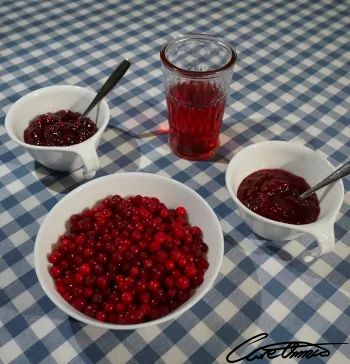
Lingonberries have a special taste that one needs to get used to. It's not sweet as many other berries can be. But it’s well worth trying. I believe most people think that the lingonberry tastes good. Due to the fact that the berry is not so sweet, it’s great to have in cooking.
If you really want to dive in to what lingonberries taste like, you should check out our article What do lingonberries taste like?
We write about the taste of fresh and frozen lingonberries, traditional jam and raw-stirred made from lingonberries, dried lingonberries, lingonberry powder, juice, tea and smoothies. The article also includes some recipes if you are interested in making something of the berries.
If you don’t have access to lingonberries but still want to try them out I recommend that you check out our Recommended By Care Omnia: Lingonberries page where we have carefully selected products with quality for you and your loved ones.
Watch Out! Lingonberries Are Heat Sensitive
You can make jam, juice or tea of lingonberries. The most common way we eat lingonberries is in the form of jam. Unfortunately, in the process of making the traditional lingonberry jam, some of the nutrients might decrease or disappear completely. That is why we first and foremost eat raw-stirred lingonberry jam ourselves.
It is during the heating that some of the nutrients disappear. ◳ For example, vitamin C is very heat sensitive. Furthermore, you usually add a lot of sugar when you make jam or juice, which is not so healthy.
This means that if you want to get the most out of a lingonberry, it's most useful to eat them just as they are, directly from the bush or frozen. There is also dried lingonberries and lingonberry powder that you can eat and still get all the nutrients.
Lingonberry jam is the most common way to consume lingonberries. To make a lingonberry jam you cook it. This is very unfortunate, but there is a jam you can eat that still contains all the nutrients that you can find in the raw berry.
It is the raw-stirred lingonberry jam. That is a jam that originally (and if you make it yourself) only contains lingonberries and sugar. The jam doesn't need to be cooked. So there is no heating involved. It’s so easy to make yourself. And it’s very tasty. In Scandinavia it’s one of the most common jams we eat.
If you have fresh or frozen lingonberries I urge you to try making raw-stirred lingonberry jam. The added sugar tones down the tartness of the fresh berries, which makes the taste more pleasant and balanced. We have a super-easy recipe on the raw-stirred lingonberry jam in our article named Taste Of Lingonberries: Fresh, Frozen, Jams, Juice + More that I really recommend you check out.

Lingonberries Reduces Effects of Fatty Foods
Obesity and diabetes researcher Karin Berger and PhD student Lovisa Heyman at the Anti Diabetic Food Center, a research center at Lund University in Sweden, made a discovery in 2014 when they researched lingonberries. They found that lingonberries inhibits the effects of fatty foods if the fat and lingonberries are consumed during the same meal.
They looked at eight different berries which they tested on a certain type of mice that easily put on fat. The mice used in the test corresponded to people with obesity and risk of diabetes. After three months, the mice were compared and it turned out that the lingonberry-diet group had by far the best results.
The mice who ate lingonberries had not gained any more weight than those mice who had low fat diet, and their blood sugar and insulin values measured the same values that the low-fat-diet mice did. The cholesterol levels and fat values in the liver were also lower than in the other mice.
According to the researchers in Lund, there has never been a similar study with lingonberries before. ◳
Lingonberry Jam Doesn't Need Preservatives
Lingonberries contain benzoic acid. Benzoic acid is a natural preservative, which means that when you make lingonberry jam and lingonberry juice you do not need to add preservatives.
The benzoic acid salts are called benzoates. Benzoic acid are effective against yeast and molds and some bacteria.
The lingonberry jam and juice also have a long shelf life thanks to the benzoic acid, without the need to add a lot of sugar.
However, due to the high benzoic acid content of the lingonberries, some people who are sensitive to fruit acids may react allergically to the berries. It's a reaction that resembles that which some people can get from acetylsalicylic acid or aspirin.
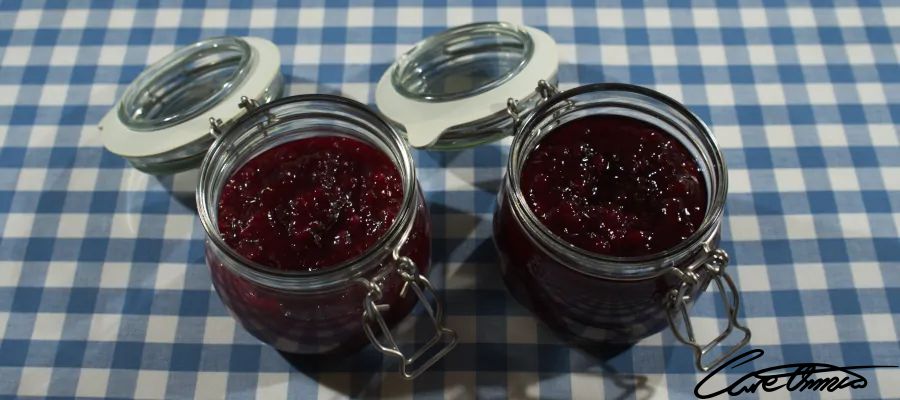
You Can Grow Lingonberries Yourself!
You can grow lingonberries in your own garden, but it's quite unusual. Lingonberries cultivation is growing more and more, especially in North America, where the lingonberries has been noted for its health effects and good taste. For example, lingonberries grows wild in Canada but it wasn't until 2015 as they really understood how important and fantastic this berry is.
The Government of Canada wrote an article about the “Lure of the lingonberry: Win-Win for Northern Agriculture and Heart Health” ◳. This was when they seriously started to look into the lingonberry as a new super berry.
It's not easy to find, but there are plant shops where you can buy lingonberry plants. A full grown lingonberry plant can give up to one liter of berries.
You can plant lingonberry bushes throughout the year, but you should avoid any ground frost when you plant it. The lingonberries like places that are damp and shady in your garden. Lingonberries are quite easy to reproduce, so I recommend you invest in a few single plants and get them to reproduce yourself.
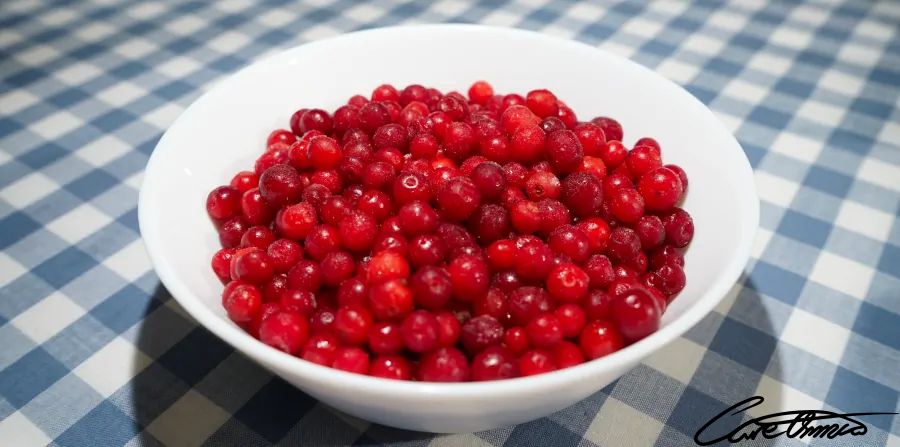
Where to buy lingonberries
Lingonberries comes in many different forms. You can find fresh, frozen, dried, powder, jam and juice. They aren’t always easy to come by but to help you in your quest to find good quality lingonberries or lingonberry products, I’ve put together a list of things I really can recommend.
It’s stuff I use myself, and I’m very meticulous with the foods I eat and the foods I serve to my family. Please check out our list of recommended products by Care Omnia: Lingonberries.
Conclusion: We Choose The Lingonberry Because Of its Taste And The Health Benefits It Provides
Lingonberries are amazing! Nutritious, tasty, versatile and just beautiful. They are quite similar to cranberries but the lingonberry actually contains more nutrients than the cranberry.
We have cranberry in Scandinavia as well, but I choose the lingonberry over the cranberry as it's healthier and you just can't beat the unique taste of lingonberries!
Jam is the most common way to eat lingonberries, but be careful when choosing lingonberry jam. There are alternatives that are more nutritious than others.
For instance the raw-stirred lingonberry jam is a healthier alternative to the traditional lingonberry jam. It’s also very easy to make yourself.
Lingonberries are known for their high content of vitamins and antioxidants. The list of countries that have found this beautiful little red berry and it’s health benefits grows steadily. The research of the berries benefits is ongoing and extensive.
The lingonberry is called a super berry. And in my opinion it’s a well earned title!
Perhaps, a few years down the road, we might have a second “lingonberry-rush”.
This time globally.
What a sight that would be!



 TM
TM